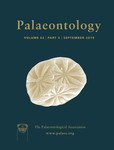Reg. Charity No. 1168330

An understanding of local and regional climate trends is essential to investigate the remarkable angiosperm radiation that happened during the Albian–Cenomanian transition. However, many of the inland depositional environments pioneered by the first modern angiosperms are poorly represented in the fossil record. Eastern Canada, in particular, has a very poor Mesozoic record. In this paper, we present the first multivariate palaeoclimate analysis (CLAMP) for the environment of a geologically isolated woody dicot dominated flora found in the Redmond no.1 mine, Labrador, near Schefferville, with an estimated Cenomanian age. It reveals that the Redmond flora would have experienced a mean annual temperature of 15.1 ± 2.1°C, one of the coolest recorded for North America at this time. These results confer the Redmond no.1 site a warm temperate and fully humid climate with a hot summer, in accordance with previous qualitative palaeoclimate estimates. This flora fits smoothly into palaeolatitudinal MAT gradients that use other Cenomanian‐estimated North American floras. Despite an inland setting, the climate analysis does not recover a significantly higher degree of seasonality than the sites to which it is compared, which agrees with established climate equability models for the Cretaceous and Palaeogene. This study also introduces 15 new morphotypes discovered in recent fieldwork. The eventual description of the species they represent may refine our dating estimates for the Redmond Formation. A greater understanding of the depositional environment and of the natural history of these angiosperms is required to improve this community's characterization, along with estimates from other proxies.